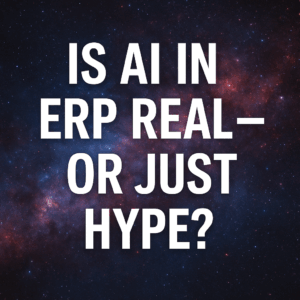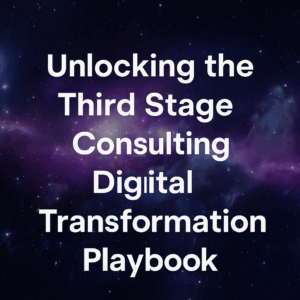Table of Contents
ToggleIntroduction
Enterprise Resource Planning (ERP) systems have become integral to the modern business landscape, offering an array of functionalities that streamline various business processes under one comprehensive framework. These systems integrate critical business functions such as Finance, HR, Manufacturing, Supply Chain Management, and more, allowing for a more coordinated and efficient approach to business management. The advent of ERP systems marked a significant shift in how companies organize and analyze data, making it easier to access real-time information and make informed decisions.
Understanding the lifecycle of an ERP system is crucial for businesses, as it encompasses more than just the implementation of technology. It is a journey that begins with the identification of business needs and extends through selection, implementation, integration, and maintenance, eventually leading to upgradation or replacement. Each phase of this lifecycle carries its own set of challenges and opportunities, and the manner in which a business navigates these stages can significantly impact its overall efficiency, adaptability, and competitiveness.
An in-depth understanding of the ERP lifecycle helps businesses to better align their ERP strategies with their organizational goals, ensuring that they reap the full benefits of their investment. Moreover, it provides insights into how to adapt these systems over time to evolving business environments and technological advancements, ensuring long-term relevance and sustainability.

I. The Conceptualization Phase:
The Selection Phase is not just about picking a software solution; it’s about choosing a strategic partner that will support the business’s objectives and growth over many years. This phase requires a deep dive into the specific features and capabilities of various ERP systems.
Businesses must consider how each system can handle their unique processes, such as inventory management, customer relationship management, or financial reporting. Customization options are also a critical factor, as they determine how well the system can be tailored to fit the specific workflows and business practices.
In addition to software capabilities, companies must also assess the track record and reputation of ERP vendors. This includes evaluating their history in the industry, customer service quality, and the level of post-implementation support they offer. The relationship with the vendor is key, as they are the ones who will provide necessary updates, training, and technical support throughout the ERP system’s lifecycle.
Moreover, the cost implications of different ERP systems are a major consideration. This not only includes the initial investment in the software but also the long-term costs associated with its maintenance, upgrades, and any additional modules or customizations needed. Businesses must balance their budget constraints with the need for a robust system that can efficiently handle their operations.
Another aspect to consider is the scalability of the ERP system. As a business grows and evolves, its ERP system should be able to accommodate new processes, additional users, and expanding operations without significant disruptions or costly upgrades. Scalability ensures that the ERP system remains a valuable tool in the long term, adapting to the changing needs of the business.
The Selection Phase also often involves stakeholders from various departments within the organization. Since ERP systems impact multiple facets of a business, it’s important to gather input from different teams to ensure that the chosen system meets the needs of the entire organization. This collaborative approach helps in building a consensus and ensures that the selected ERP system is well-received across the company.
Finally, businesses may also consider the technological architecture of the ERP systems, such as cloud-based versus on-premise solutions. Each option has its own set of advantages and challenges, and the choice depends on factors like data security needs, accessibility, and the company’s IT infrastructure.
II. The Selection Phase:
During the Selection Phase of an ERP (Enterprise Resource Planning) system, businesses face the intricate task of choosing a system that best aligns with their specific needs and objectives. This phase involves a detailed analysis of various criteria to ensure the chosen ERP solution effectively supports and enhances the organization’s operations.
One of the foremost criteria in selecting an ERP system is its functionality. Businesses need to assess whether the system can handle their unique processes, such as supply chain management, financial reporting, or human resources. This involves a deep dive into the specific features offered by each system and how they can be tailored to fit the organization’s unique workflows and practices. The degree of customization available is crucial, as it determines the flexibility of the system to adapt to specific business requirements.
Another key aspect of the selection process is comparing different ERP solutions available in the market. This comparison is not just limited to the features and capabilities of the systems but also includes evaluating their scalability, user-friendliness, and integration capabilities with existing systems and technologies. A side-by-side comparison of various systems helps in understanding the strengths and weaknesses of each option and how they align with the business’s long-term goals.
The cost of the ERP system, including both the initial investment and the long-term expenses associated with maintenance, upgrades, and additional customizations, is a significant factor in the selection process. Businesses must carefully evaluate their budget and the ROI (Return on Investment) expected from the ERP system, balancing financial constraints with the need for a comprehensive and efficient solution.
In addition to these considerations, the role of vendors and consultants in the selection phase is pivotal. ERP vendors bring in their expertise and insights about the system, offering support and guidance throughout the implementation process. Their reliability, customer service quality, and commitment to post-implementation support are essential factors to consider.
Consultants, on the other hand, can offer unbiased advice, helping businesses navigate through the complexities of ERP selection. They can assist in identifying the specific needs of the business, matching these needs with the right ERP solution, and providing insights on industry best practices.
Lastly, businesses also consider the technological architecture of the ERP systems, weighing the pros and cons of cloud-based solutions against on-premise installations. Factors like data security, accessibility, and compatibility with the existing IT infrastructure play a crucial role in this decision.
To learn more about effective software selection, listen to our Digital Stratosphere Podcast episode titled – Implementation Success Requires Good Software Selection.
III. The Implementation Phase:
The Implementation Phase of an ERP (Enterprise Resource Planning) system is a pivotal stage in its lifecycle, encompassing a series of steps that transform strategic plans into operational solutions. This phase begins with the meticulous planning and design of the system, tailored to the specific needs and processes of the business.
It involves setting up the infrastructure, configuring the software, and integrating it with existing systems. A critical step in this phase is data migration, where existing data is transferred to the new ERP system, a task that demands precision and thorough validation to ensure data integrity and accuracy.
One of the common challenges during the implementation phase is managing the change within the organization. The introduction of a new system often disrupts established workflows, which can lead to resistance from employees. To mitigate this, businesses must develop a comprehensive change management strategy that includes clear communication about the benefits of the new system and how it will improve day-to-day operations. This strategy should also address any concerns or apprehensions that employees might have, ensuring they feel supported throughout the transition.
Another significant challenge is ensuring that the ERP system is implemented within the planned timeline and budget. Delays and cost overruns are not uncommon, often due to unforeseen complexities or changes in business requirements. To combat this, it’s vital to have a robust project management approach, with regular reviews and adjustments to the project plan as needed. This approach helps in identifying potential issues early and addressing them before they escalate.
The technical aspects of implementation, such as system customization and integration with other tools and platforms, can also present challenges. These technical complexities require a skilled IT team or external experts who can ensure that the system is set up correctly and functions seamlessly with other business processes.
Furthermore, the importance of employee training and engagement in this phase cannot be overstated. For an ERP system to be effective, it is essential that the staff who will use it are well-trained and comfortable with its features and functionalities. This training should be comprehensive and ongoing, covering not only how to use the system but also how it fits into the larger business processes. Engaging employees early in the implementation process, possibly even involving them in the planning stages, can foster a sense of ownership and ease the adoption of the new system.

IV. The Integration and Testing Phase:
The Integration and Testing Phase of an ERP (Enterprise Resource Planning) system’s lifecycle is a crucial stage where the newly implemented system is harmoniously blended with the organization’s existing processes and systems. This phase is pivotal for ensuring that the ERP system not only functions in isolation but also works effectively within the broader technological ecosystem of the organization.
Integration involves meticulously connecting the ERP system with various existing business applications and databases. This process is fundamental to creating a seamless flow of information across different areas of the business, such as Finance, Sales, Inventory, and Customer Relationship Management. The goal is to ensure that data moves fluidly between the ERP system and other software solutions, eliminating data silos and fostering a unified view of business operations.
This integration requires a deep understanding of both the ERP system and the existing technological infrastructure. Challenges often arise in aligning different data formats, workflows, and software interfaces. Overcoming these challenges necessitates careful planning, skilled technical expertise, and often, the use of middleware or integration tools that can bridge the gap between disparate systems.
Concurrently, the Testing Phase plays a critical role in ensuring that the integrated ERP system operates as intended. This involves a series of rigorous tests to validate every aspect of the system’s functionality and compatibility with existing processes. Testing is not a one-time event but a continuous process that includes various types of tests such as unit testing, system testing, integration testing, and user acceptance testing.
Each of these tests serves a specific purpose. For instance, unit testing ensures that individual components of the ERP system function correctly, while integration testing checks the interactions between the ERP system and other applications. User acceptance testing, perhaps the most critical, involves end-users testing the system to confirm that it meets their business requirements and workflows.
One of the challenges in this phase is ensuring that the testing is comprehensive and realistic. It should cover not just typical use cases but also edge cases and potential failure scenarios. This is vital to uncover any issues that could disrupt business operations once the system goes live. Another challenge is maintaining the balance between thorough testing and meeting project timelines. Extensive testing can be time-consuming, but it is essential for preventing costly errors and downtime after the system is fully operational.
Effective communication and collaboration among IT professionals, end-users, and management teams are crucial throughout this phase. Their collective insights and feedback ensure that the ERP system is not only technically sound but also aligns with the practical needs of the business.

V. The Deployment Phase:
The Deployment Phase of an ERP (Enterprise Resource Planning) system is a critical juncture where the system, having been thoroughly tested and integrated, is finally set to go live. This phase demands strategic planning and meticulous execution to ensure a successful roll-out.
Key strategies for a successful deployment start with a well-defined roll-out plan that outlines the sequence of activities leading to the ERP system going live.
This plan typically includes finalizing configurations, completing any necessary data migration, and ensuring all systems are fully operational. A phased approach is often employed, where the ERP system is rolled out in stages, either by module, department, or location. This incremental deployment can help in managing risks, as it allows for monitoring and resolving issues on a smaller scale before a full-scale implementation.
Managing change within the organization during the deployment phase is another critical component. This involves clear and ongoing communication with all stakeholders about the changes to come, the benefits of the new system, and the support available to them. Change management strategies should be aimed at minimizing resistance and building positive anticipation for the new system. This can be achieved through continuous engagement with employees, addressing their concerns, and involving them in the process to foster a sense of ownership and ease the transition.
Ensuring business continuity during the transition is essential. Disruptions to day-to-day operations should be minimized to maintain productivity and customer service levels. This involves having contingency plans in place to handle any unforeseen issues that arise during deployment. Businesses often maintain parallel operations of the new ERP system and the old systems for a short period, providing a safety net while the new system is being fine-tuned.
Training plays a vital role during the deployment phase. Comprehensive training ensures that employees are well-equipped to use the new ERP system effectively. This training should be tailored to different user groups within the organization, focusing on the specific functionalities and processes relevant to their roles.
VI. The Maintenance and Support Phase:
The Maintenance and Support Phase is an ongoing and essential part of the ERP (Enterprise Resource Planning) system’s lifecycle. After the deployment phase, attention shifts to ensuring that the system continues to operate smoothly and effectively over time. This phase involves regular maintenance, which is crucial for the longevity and efficiency of the ERP system.
Ongoing maintenance requirements for ERP systems include monitoring system performance, troubleshooting issues, and making adjustments to improve functionality and efficiency. Regular system audits are conducted to identify areas for optimization, ensuring that the ERP system remains aligned with the changing needs of the business.
The role of vendor support in this phase is significant. ERP vendors typically offer support services as part of their package, which includes access to technical expertise, updates, and troubleshooting assistance. This support is vital for resolving complex issues that may arise and for providing guidance on best practices for system usage and maintenance. The relationship with the vendor is often a long-term partnership, as they continue to play a key role in the system’s performance and evolution.
In-house IT teams also have a crucial role in the maintenance and support phase. They are responsible for the day-to-day management of the ERP system, addressing user queries, and ensuring that the system integrates seamlessly with other business operations. The in-house team works closely with the vendor to resolve technical issues and to implement updates and patches.
Planning for regular updates and patches is another important aspect of this phase. These updates are necessary to address security vulnerabilities, fix bugs, and add new features or enhancements to the system. Keeping the ERP system up-to-date is essential for maintaining its security and efficiency. However, implementing these updates requires careful planning to minimize disruptions to business operations. This often involves scheduling updates during off-peak hours, conducting thorough testing before going live, and preparing contingency plans in case of any issues.
VII. The Evolution and Upgradation Phase:
The Evolution and Upgradation Phase in the lifecycle of an ERP (Enterprise Resource Planning) system is a period marked by adaptation and growth, reflecting the dynamic nature of both technology and business environments. In this phase, organizations must make critical decisions about upgrading or potentially replacing their ERP systems to stay abreast of technological advancements and evolving business needs.
Recognizing when to upgrade or replace an ERP system is a significant decision that hinges on several factors. Organizations must continually assess the performance and capabilities of their current system against their operational requirements and growth objectives. Signs that an upgrade or replacement might be necessary include the system’s inability to support new business processes, compatibility issues with other technologies, poor system performance, and escalating maintenance costs.
Additionally, as businesses expand or change direction, they might find their current system no longer aligns with their strategic goals. An ERP system that once was a perfect fit may now be a constraint due to its limitations in scalability, functionality, or integration capabilities.
Keeping up with technological advancements is another driving force in this phase. The rapid pace of technological change can render an older ERP system obsolete, both in terms of functionality and security. Newer ERP systems often offer enhanced features, such as advanced analytics, improved user interfaces, cloud-based services, and better integration capabilities with other digital tools. Adapting to these advancements can significantly improve operational efficiency, data accuracy, and decision-making processes within the organization.
Case studies of successful ERP upgrades and transformations serve as valuable learning tools. They provide insights into best practices, strategies, and lessons learned from other organizations’ experiences. For example, a case study might illustrate how a company successfully managed the transition from an on-premise ERP system to a cloud-based solution, highlighting the challenges faced and the benefits realized post-implementation.
Another case might showcase how an organization integrated advanced analytics into their ERP system, leading to improved data-driven decision-making and operational efficiencies.
These case studies not only offer practical guidance but also demonstrate the tangible benefits of staying current with ERP technology. They underscore the importance of a proactive approach to system evolution, ensuring that the ERP system continues to be a valuable asset in supporting and driving business growth.
Conclusion
In conclusion, the lifecycle of an ERP (Enterprise Resource Planning) system encompasses various critical phases, each playing a pivotal role in ensuring the system effectively supports and enhances organizational operations. From the initial selection and careful implementation to the crucial stages of integration, testing, and deployment, followed by ongoing maintenance and eventual evolution or upgrade, each phase demands strategic planning and meticulous execution.
Understanding and navigating these phases skillfully is essential for businesses to fully leverage their ERP systems, thereby driving operational efficiency, adapting to changing business needs, and ultimately achieving sustained growth and success in a dynamic business environment.
I would enjoy brainstorming ideas with you if you are looking to strategize for an upcoming transformation or are looking at selecting an ERP system. Please feel free to contact me at eric.kimberling@thirdstage-consulting.com. I am happy to be a sounding board as you continue your digital transformation journey.





